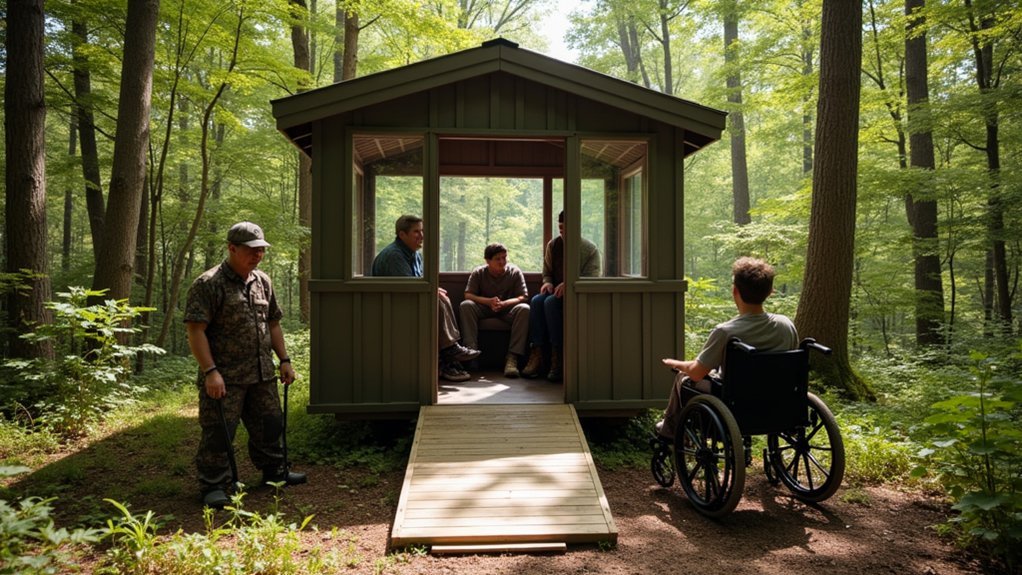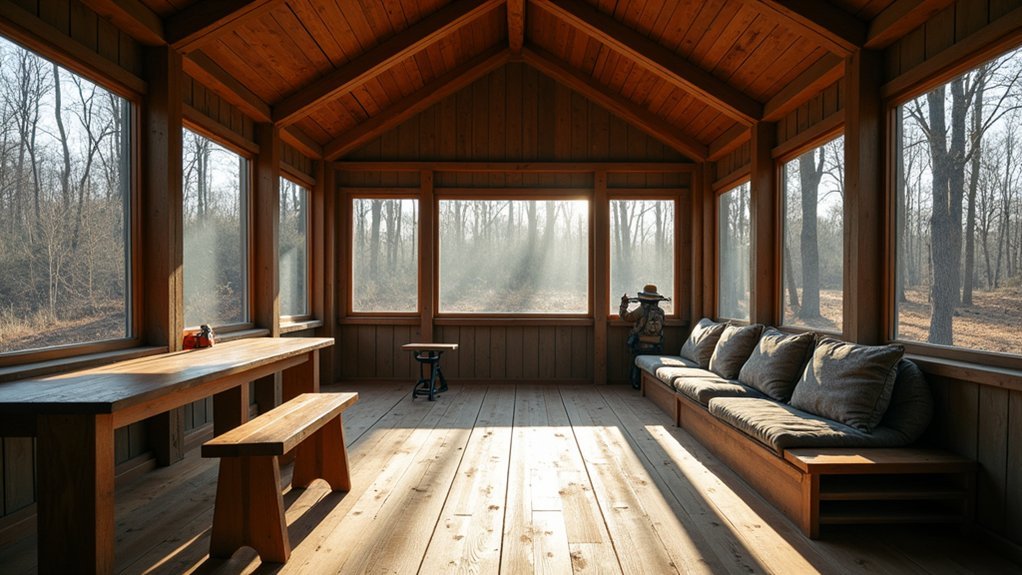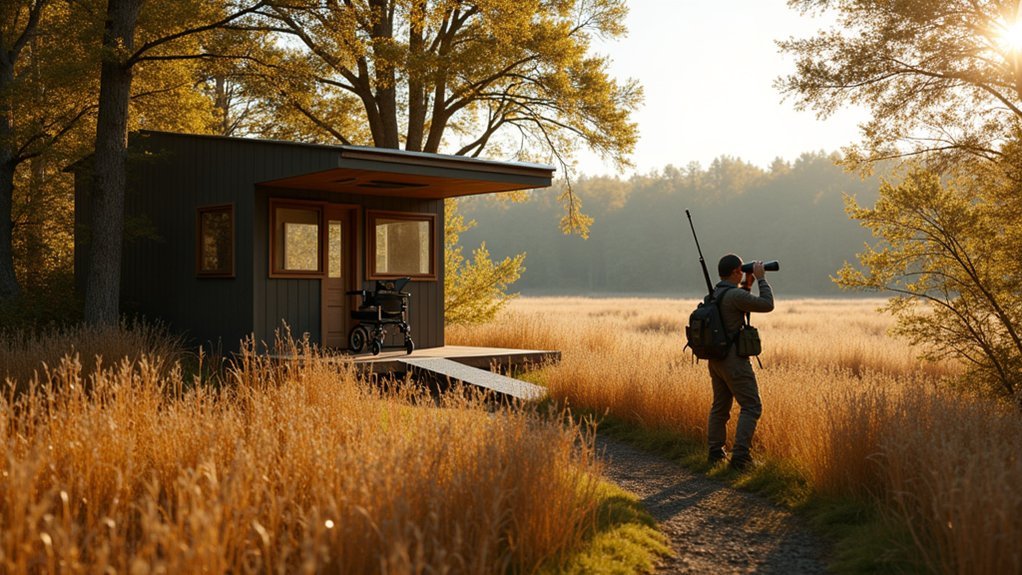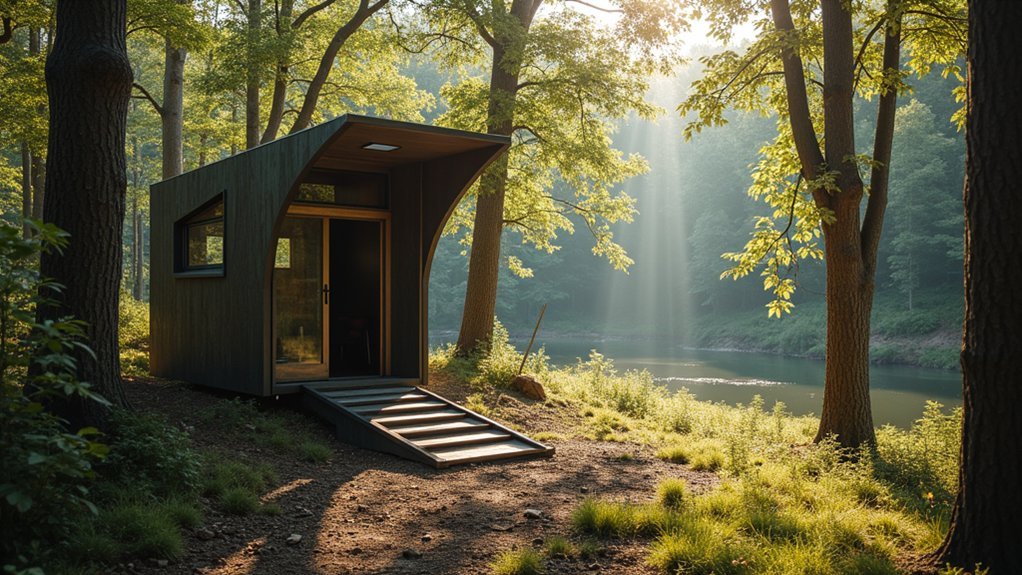Mobility-friendly hunting blinds feature wide doorways (41+ inches), flat thresholds, spacious interiors, and accessible shooting windows for hunters of all abilities. Look for models with weather-resistant materials, proper insulation, and simple entry designs. Top options offer at least 6’x6′ interior space to accommodate wheelchairs and companions comfortably. When setting up, create level approach paths and position blinds downwind from game trails. These accessible designs don’t just comply with ADA standards—they transform the hunting experience for everyone involved.
Why Accessibility Matters in Modern Hunting Blinds

While hunting traditions date back generations, the modern hunting landscape is evolving to become more inclusive and accommodating.
You’ll find this shift isn’t just about goodwill—it’s often legally required, as many public lands must provide accessible facilities for all users under ADA regulations.
The demand for accessible outdoor activities continues to grow, creating economic benefits for communities that embrace inclusive design.
When you invest in mobility-friendly blinds, you’re expanding participation opportunities and promoting social inclusion, allowing friends and family of all abilities to share the hunting experience.
State-specific guidelines complement federal requirements, creating a framework that guarantees everyone can enjoy the outdoors.
The increasing female hunter participation is driving manufacturers to develop more accessible and comfortable blind designs with features like backrests and adjustable seating.
Top Features to Look for in Mobility-Friendly Blinds
When shopping for mobility-friendly hunting blinds, you’ll want to prioritize designs with wide doors and flat thresholds for easy wheelchair entry.
Your blind should offer ample interior space to accommodate mobility equipment while allowing comfortable movement during extended hunts.
Look for weather-resistant materials and proper insulation that’ll keep you protected from harsh elements, ensuring your accessible hunting experience remains comfortable regardless of conditions. Superior options like the Ambush Handicap Accessible Blinds feature sound dampening technology to maintain stealth during your hunting sessions.
Entry Design Matters
Because access can make or break a hunting experience for those with mobility challenges, entry design stands as perhaps the most critical feature of accessible blinds.
Look for doors at least 41 inches wide to accommodate wheelchairs and Action Trackchairs. Flat thresholds eliminate barriers and prevent tripping as you enter.
Don’t overlook the importance of ADA-compliant ramps and leveling systems, which provide stability on uneven terrain.
Easy-to-use handles and grips are essential if you have limited hand strength or use mobility aids.
The best mobility-friendly blinds feature a simplified entry process with minimal obstacles and easy-open doors. Some premium models offer extra wide door options of 40 inches specifically designed for wheelchair accessibility.
These thoughtful design elements reduce stress and frustration, allowing you to focus on what matters most—enjoying your hunt regardless of physical limitations.
Space for Mobility Equipment
Interior dimensions make all the difference when selecting a blind that accommodates mobility equipment. You’ll want a spacious design that allows for wheelchair maneuverability without compromising shooting opportunities.
| Feature | Benefit |
|---|---|
| Large footprint (6’x6′ or larger) | Accommodates wheelchairs plus companions |
| Wide doorways (39″+ clearance) | Guarantees easy entry/exit without struggle |
| Flat thresholds | Eliminates barriers for rolling devices |
| Flexible window placement | Enables shooting from seated positions |
Look for modular designs that can be adapted to your specific needs. Panelized construction offers dual benefits: easier transport to remote locations and customizable configurations. The customizable setup enhances your ability to tailor the blind for specific accessibility requirements. The best mobility-friendly blinds balance interior space with practical features that don’t restrict movement, allowing you to position your chair effectively for different shooting angles and game approaches.
Weather-Protected Hunting Experience
Serious hunters with mobility equipment understand that weather protection isn’t just about comfort—it’s essential for accessibility and hunt success.
Look for blinds with waterproof materials and sealed seams that prevent moisture from compromising your position during unexpected rainfall.
Choose models featuring durable fiberglass or metal components that withstand harsh conditions while maintaining stability for mobility equipment.
Premium blinds offer proper ventilation systems that regulate temperature and reduce condensation, keeping your gear dry and functional.
For maximum weather protection without sacrificing visibility, select blinds with adjustable windows that can be modified quickly as conditions change.
The best mobility-friendly options combine weather resistance with thermal insulation, creating a comfortable environment even during extended hunts in challenging conditions.
This protection guarantees you can focus on the hunt rather than discomfort from the elements.
Setting up blinds well in advance of your hunting date allows game to acclimate to their presence, increasing your chances of a successful and comfortable hunt.
The Most Wheelchair-Accessible Blind Models of 2023
Hunters with mobility challenges will find 2023’s wheelchair-accessible blinds offering unprecedented freedom and functionality in the field. The Ambush models feature 41″ doors with 38-3/4″ openings that accommodate most wheelchairs, including Action Trackchairs, with flat thresholds for smooth entry. Monster Handicap Accessible Deer Blinds come with fully insulated 2-inch walls, floors, and ceiling for year-round comfort.
| Model | Key Features | Weight Capacity |
|---|---|---|
| Orion 5×5 | ADA ramps, adjustable chairs | 350 lbs |
| Orion 6×6 | Leveling stands, caster seating | 450 lbs |
| Ambush Stalker | Octagon shape, 360° visibility | Multiple hunters |
Texas Wildlife Supply blinds offer 7-foot wall heights with specialized accessibility design. All these models feature panelized construction for easy assembly, requiring minimal tools and enabling quick relocation to your preferred hunting spots when needed.
Customizing Your Blind for Specific Mobility Needs

When outfitting a hunting blind for specific mobility challenges, customization becomes essential rather than optional.
Modular blinds with panelized construction allow you to create the ideal setup for your unique needs while simplifying transport and assembly.
Flexible panelized designs make custom mobility adaptations simple while ensuring your blind remains portable and user-friendly.
For wheelchair users, prioritize blinds with wide doors, flat thresholds, and ADA-compliant ramps.
Many manufacturers offer larger door options with minimal additional cost to accommodate various wheelchair types, including Action Trackchairs.
Don’t overlook the importance of adjustable seating.
Height-adjustable chairs with casters let you position yourself effortlessly, reducing fatigue during long waits.
Leveling stands provide critical stability on uneven terrain, enhancing both safety and comfort.
Consider additional accessories like floor mats and customizable window configurations to further tailor your blind to your specific mobility requirements.
When choosing a brand, Orion outperforms competitors like Redneck and Muddy Outdoors with their ADA-compliant features that prioritize accessibility without sacrificing quality.
Setting Up Accessible Blinds: Placement and Preparation Tips
Strategic placement of accessible hunting blinds can make the difference between a frustrating hunt and a successful one, especially for hunters with mobility challenges.
Position your blind downwind from game paths to prevent scent detection, while avoiding direct sunlight that creates distracting shadows.
Create a discreet, level approach route using natural cover to shield your movements. Build natural wings or plant additional cover to create an undetected access path to your blind. Scout locations beforehand to understand game patterns, placing your blind near—but not too close to—trails and feeding areas.
Guarantee your setup offers clear shooting lanes without being directly in animals’ line of sight.
Regularly maintain your blind’s structure and camouflage, blending it with local vegetation.
For maximum comfort and effectiveness, incorporate airtight features for scent control and guarantee doors and platforms accommodate your specific mobility needs.
Stories From the Field: How Adaptive Blinds Changed the Hunting Experience

You’ll find that adaptive blinds have united hunters of all abilities in the field, creating meaningful connections that transcend physical limitations.
When wheelchair users and veterans with mobility challenges return to hunting thanks to these accessible setups, their faces light up with rekindled passion for an activity they thought was lost to them.
These blinds don’t just provide a place to hunt—they restore independence and dignity while allowing hunters to share their experiences with family and friends who support them.
Organizations like Hunt 2 Heal have demonstrated how wheelchair-friendly trails and accessible hunting blinds can transform lives by making outdoor experiences possible for people with disabilities.
Breaking Barriers Together
Throughout the country, hunters with disabilities are rewriting the narrative of what’s possible in the field, thanks to innovative adaptive blinds and collaborative community efforts.
You’ll find state agencies partnering with organizations to share success stories and demonstrate the value of accessible hunting environments.
When you participate in these collaborative initiatives, you’re helping break down both physical and social barriers.
These efforts foster a more diverse hunting community where experiences are shared among hunters of all abilities.
The visibility of adaptive hunting successes isn’t just inspiring disabled hunters—it’s motivating everyone toward more inclusive practices.
Minnesota’s recent commitment to building hydraulic lift blinds represents a significant advancement in making hunting truly accessible for everyone.
Rediscovering Hunting Joy
Three powerful stories from adaptive blind users illustrate how these specialized structures have transformed their hunting experiences.
You’ll find that adaptive blinds don’t just enable hunting—they restore independence and joy that many thought was lost forever.
- A Vietnam veteran with limited mobility described regaining his passion after using a wheelchair-accessible blind with ample turning space, stating it was the first time in decades he’d hunted without feeling like a burden.
- A hunter with MS shared how track chairs and elevated blinds allowed her to access terrain she hadn’t visited in years, reconnecting her with favorite hunting spots. The spacious interior design made it comfortable for her and a companion to hunt together while providing enough room for her mobility equipment.
- A father with paralysis expressed how adaptive blinds enabled him to pass hunting traditions to his children, something he feared impossible after his accident.
Frequently Asked Questions
How Long Do Mobility-Friendly Blinds Typically Last?
Your mobility-friendly blinds typically last 5-15 years depending on materials. Fiberglass and rotomold options offer greater durability, while proper maintenance extends their lifespan. Hard-sided blinds generally outlast soft-sided portable versions.
Can Accessible Blinds Be Modified After Purchase?
Yes, you can modify accessible blinds after purchase by adding custom ramps, elevation kits, skids for mobility, structural upgrades for comfort, and custom paint jobs to improve camouflage for your specific hunting environment.
Are There Hunting Blind Rental Options for Disabled Hunters?
Yes, you’ll find rental options through Idaho Fish and Game’s portable blinds, U.S. Forest Service programs, and organizations like Outdoor Buddies and Michigan Operation Freedom Outdoors that offer equipment specifically for disabled hunters.
How Much Weight Can Accessible Blind Floors Support?
Accessible blind floors vary in capacity. You’ll find Muddy Blind Platforms supporting up to 500 pounds, while others don’t specify exact limits. Always check manufacturer specifications for weight ratings before purchasing or using accessible blinds.
Do Accessible Blinds Cost Significantly More Than Standard Models?
Yes, accessible blinds typically cost considerably more than standard models. You’ll pay premium prices for wider doors, durable materials, and specialized features, with high-end models reaching $3,000-$3,800 compared to standard blinds starting under $100.
In Summary
You’ve now got all the tools to find a hunting blind that won’t limit your outdoor experience, regardless of mobility challenges. Remember, today’s adaptive blinds offer independence and comfort that weren’t available just years ago. Don’t settle for makeshift solutions—invest in equipment that truly meets your needs. With the right mobility-friendly blind, you’ll extend your hunting seasons and create lasting memories in the field.





Leave a Reply